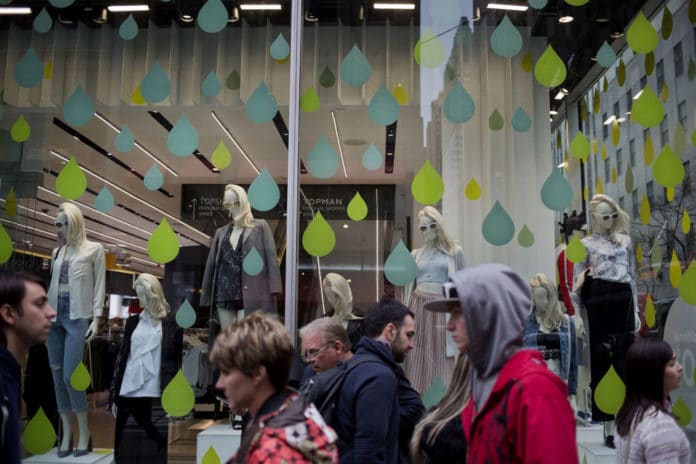Almost everything needed to propel bigger gains in U.S. consumer spending is going right, so why the restraint?
Employment is growing by leaps and bounds, gasoline prices are hovering around the lowest levels in seven years and even stocks have rebounded. Yet retail sales unexpectedly fell 0.3 percent in March, according to figures from the Commerce Department issued Wednesday in Washington.
The decrease was led by the weakest demand for autos in nine months, which in and of itself wouldn’t be much of a concern. After all, cars had been selling at such a spectacular clip that demand was bound to cool as many households have already replaced their pre-recession era clunkers.
The added buying power from a solid job market and cheap gasoline prices was supposed to be unleashed on other goods and services, if not cars. Instead, households last month cut clothing budgets, shopped less online and skipped some restaurant meals.
Without the support from more vigorous consumer spending, the world’s largest economy will be vulnerable to risks from the global slowdown that have concerned Federal Reserve policymakers.
“We’re having a little bit of a soft patch here for the consumer, with no obvious rationale,” said Michael Feroli, chief U.S. economist at JPMorgan Chase in New York. “It’s definitely a softer start to the year. Provided job gains remain as strong as they’ve been, we expect consumer spending should be OK.”
The median forecast of 81 economists surveyed by Bloomberg projected retail sales would climb 0.1 percent.
One positive aspect of the report was that revisions showed February wasn’t as bad as previously estimated. Purchases were little changed rather than dropping 0.1 percent as announced last month.
Economists cautioned against taking the report at face value. Its susceptibility to large revisions and lack of data on services — which accounts for almost 70 percent of all purchases — make the retail sales figures less critical, according to Richard Moody, chief economist at Regions Financial Corp. in Birmingham, Alabama.
“The monthly retail sales data give only a limited view on the overall state of U.S. consumers,” Moody wrote in a note after the report.
Besides, since households are using the extra cash from savings at the gas pump to repair balance sheets, they’ll emerge in better shape to step up spending when they’re ready, he said.
“We are also seeing consumers pare down debt and build up savings, neither of which should be seen as a bad thing,” Moody said in the note.
Still, not only did it amount to a disappointing first quarter, but the loss of momentum in March also made for a weak hand off into the current quarter.
The median forecast in a Bloomberg survey shows household purchases rose at a 1.9 percent annualized rate in the first quarter, the weakest in a year and down from a 2.4 percent advance in the prior three months. While still projecting a pickup this quarter, the low reading for March prompted economists at Macroeconomic Advisers in St. Louis to cut their second-quarter spending estimate to an increase of 2.9 percent from 3.4 percent before the report.
Fed policymakers have been counting on consumers to pull the economy through the headwinds of a widening trade deficit and slump in manufacturing caused by the slowdown in global growth.
“Consumer spending appears to be expanding at a moderate pace, driven by solid income gains, improved household balance sheets, and the ongoing effects of the increases in wealth and declines in oil prices over the past few years,” Fed Chair Janet Yellen said in a March 29 speech at the Economic Club of New York. “On balance, overall employment has continued to grow at a solid pace so far this year, in part because domestic household spending has been sufficiently strong to offset the drag coming from abroad.”
Without that buffer, gains in employment may be difficult to sustain.






